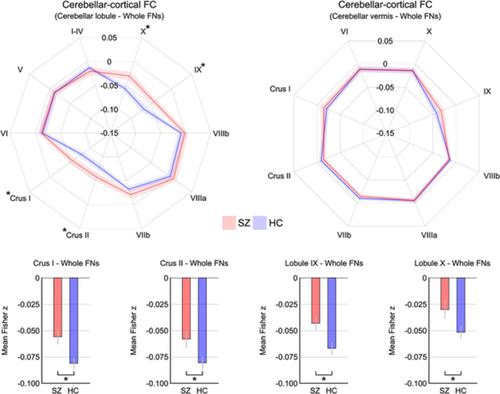当前位置:
X-MOL 学术
›
Hum. Brain Mapp.
›
论文详情
Our official English website, www.x-mol.net, welcomes your feedback! (Note: you will need to create a separate account there.)
Cerebellar-cortical dysconnectivity in resting-state associated with sensorimotor tasks in schizophrenia.
Human Brain Mapping ( IF 4.8 ) Pub Date : 2020-04-06 , DOI: 10.1002/hbm.25002 Dae-Jin Kim 1 , Alexandra B Moussa-Tooks 1, 2 , Amanda R Bolbecker 1, 3 , Deborah Apthorp 4, 5 , Sharlene D Newman 1, 2 , Brian F O'Donnell 1, 2, 3 , William P Hetrick 1, 2, 3
Human Brain Mapping ( IF 4.8 ) Pub Date : 2020-04-06 , DOI: 10.1002/hbm.25002 Dae-Jin Kim 1 , Alexandra B Moussa-Tooks 1, 2 , Amanda R Bolbecker 1, 3 , Deborah Apthorp 4, 5 , Sharlene D Newman 1, 2 , Brian F O'Donnell 1, 2, 3 , William P Hetrick 1, 2, 3
Affiliation

|
Abnormalities of cerebellar function have been implicated in the pathophysiology of schizophrenia. Since the cerebellum has afferent and efferent projections to diverse brain regions, abnormalities in cerebellar lobules could affect functional connectivity with multiple functional systems in the brain. Prior studies, however, have not examined the relationship of individual cerebellar lobules with motor and nonmotor resting‐state functional networks. We evaluated these relationships using resting‐state fMRI in 30 patients with a schizophrenia‐spectrum disorder and 37 healthy comparison participants. For connectivity analyses, the cerebellum was parcellated into 18 lobular and vermal regions, and functional connectivity of each lobule to 10 major functional networks in the cerebrum was evaluated. The relationship between functional connectivity measures and behavioral performance on sensorimotor tasks (i.e., finger‐tapping and postural sway) was also examined. We found cerebellar–cortical hyperconnectivity in schizophrenia, which was predominantly associated with Crus I, Crus II, lobule IX, and lobule X. Specifically, abnormal cerebellar connectivity was found to the cerebral ventral attention, motor, and auditory networks. This cerebellar–cortical connectivity in the resting‐state was differentially associated with sensorimotor task‐based behavioral measures in schizophrenia and healthy comparison participants—that is, dissociation with motor network and association with nonmotor network in schizophrenia. These findings suggest that functional association between individual cerebellar lobules and the ventral attentional, motor, and auditory networks is particularly affected in schizophrenia. They are also consistent with dysconnectivity models of schizophrenia suggesting cerebellar contributions to a broad range of sensorimotor and cognitive operations.
中文翻译:

与精神分裂症感觉运动任务相关的静息状态下的小脑皮质连接障碍。
小脑功能异常与精神分裂症的病理生理学有关。由于小脑具有对不同大脑区域的传入和传出投射,小脑小叶的异常可能影响与大脑中多个功能系统的功能连接。然而,之前的研究没有检查个体小脑小叶与运动和非运动静息状态功能网络的关系。我们使用静息态 fMRI 在 30 名精神分裂症谱系障碍患者和 37 名健康对照参与者中评估了这些关系。对于连通性分析,小脑被划分为 18 个小叶和 vermal 区域,并评估了每个小叶与大脑中 10 个主要功能网络的功能连通性。还检查了功能连接测量与感觉运动任务(即手指敲击和姿势摇摆)的行为表现之间的关系。我们在精神分裂症中发现了小脑 - 皮质超连通性,主要与 Crus I、Crus II、小叶 IX 和小叶 X 相关。具体来说,发现大脑腹侧注意力、运动和听觉网络的小脑连接异常。这种静息状态下的小脑 - 皮质连接与精神分裂症和健康比较参与者基于感觉运动任务的行为测量存在差异,即精神分裂症中与运动网络的分离和与非运动网络的关联。这些发现表明,个体小脑小叶与腹侧注意、运动、听觉网络在精神分裂症中尤其受到影响。它们也与精神分裂症的连接障碍模型一致,表明小脑对广泛的感觉运动和认知操作的贡献。
更新日期:2020-04-06
中文翻译:

与精神分裂症感觉运动任务相关的静息状态下的小脑皮质连接障碍。
小脑功能异常与精神分裂症的病理生理学有关。由于小脑具有对不同大脑区域的传入和传出投射,小脑小叶的异常可能影响与大脑中多个功能系统的功能连接。然而,之前的研究没有检查个体小脑小叶与运动和非运动静息状态功能网络的关系。我们使用静息态 fMRI 在 30 名精神分裂症谱系障碍患者和 37 名健康对照参与者中评估了这些关系。对于连通性分析,小脑被划分为 18 个小叶和 vermal 区域,并评估了每个小叶与大脑中 10 个主要功能网络的功能连通性。还检查了功能连接测量与感觉运动任务(即手指敲击和姿势摇摆)的行为表现之间的关系。我们在精神分裂症中发现了小脑 - 皮质超连通性,主要与 Crus I、Crus II、小叶 IX 和小叶 X 相关。具体来说,发现大脑腹侧注意力、运动和听觉网络的小脑连接异常。这种静息状态下的小脑 - 皮质连接与精神分裂症和健康比较参与者基于感觉运动任务的行为测量存在差异,即精神分裂症中与运动网络的分离和与非运动网络的关联。这些发现表明,个体小脑小叶与腹侧注意、运动、听觉网络在精神分裂症中尤其受到影响。它们也与精神分裂症的连接障碍模型一致,表明小脑对广泛的感觉运动和认知操作的贡献。



























 京公网安备 11010802027423号
京公网安备 11010802027423号